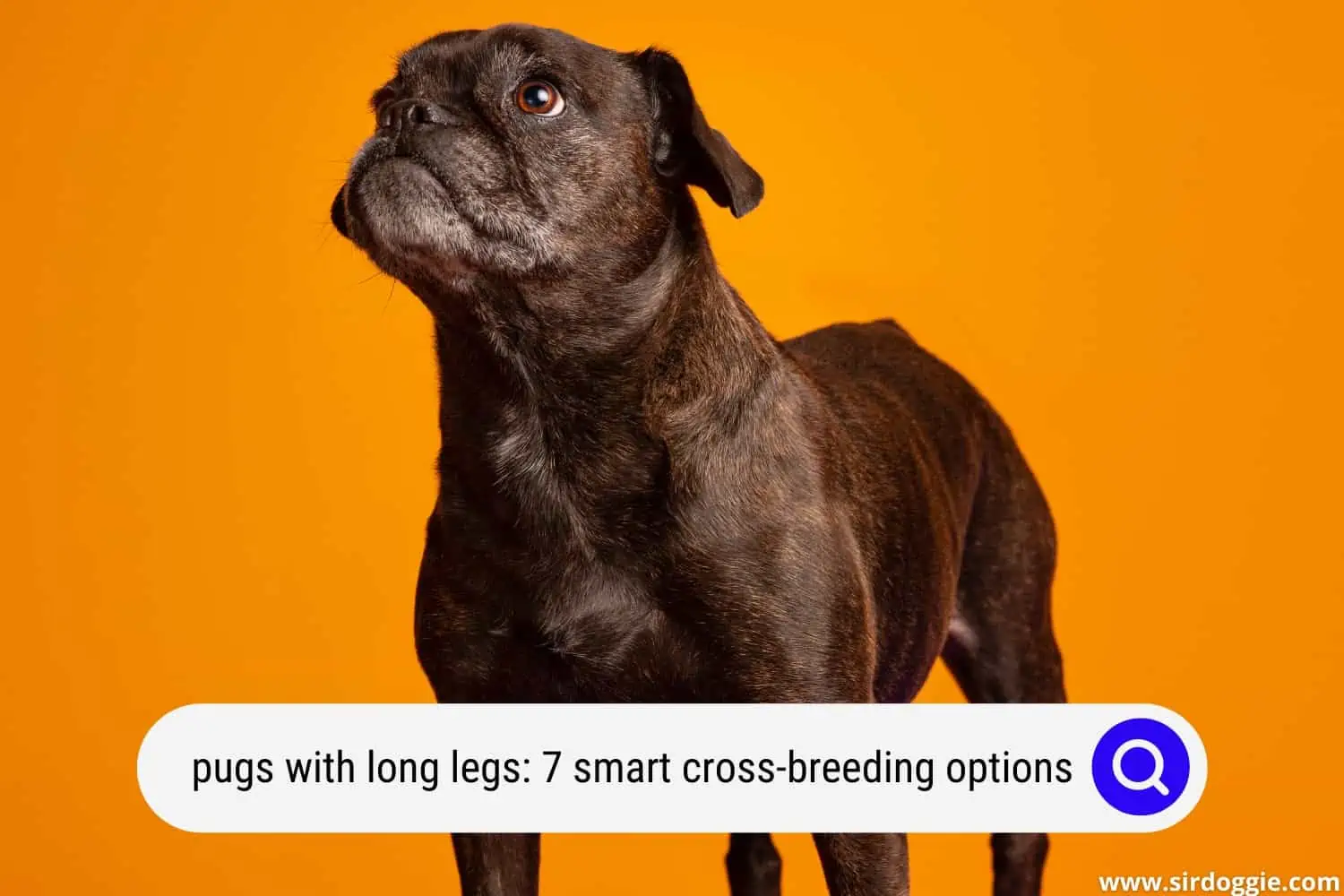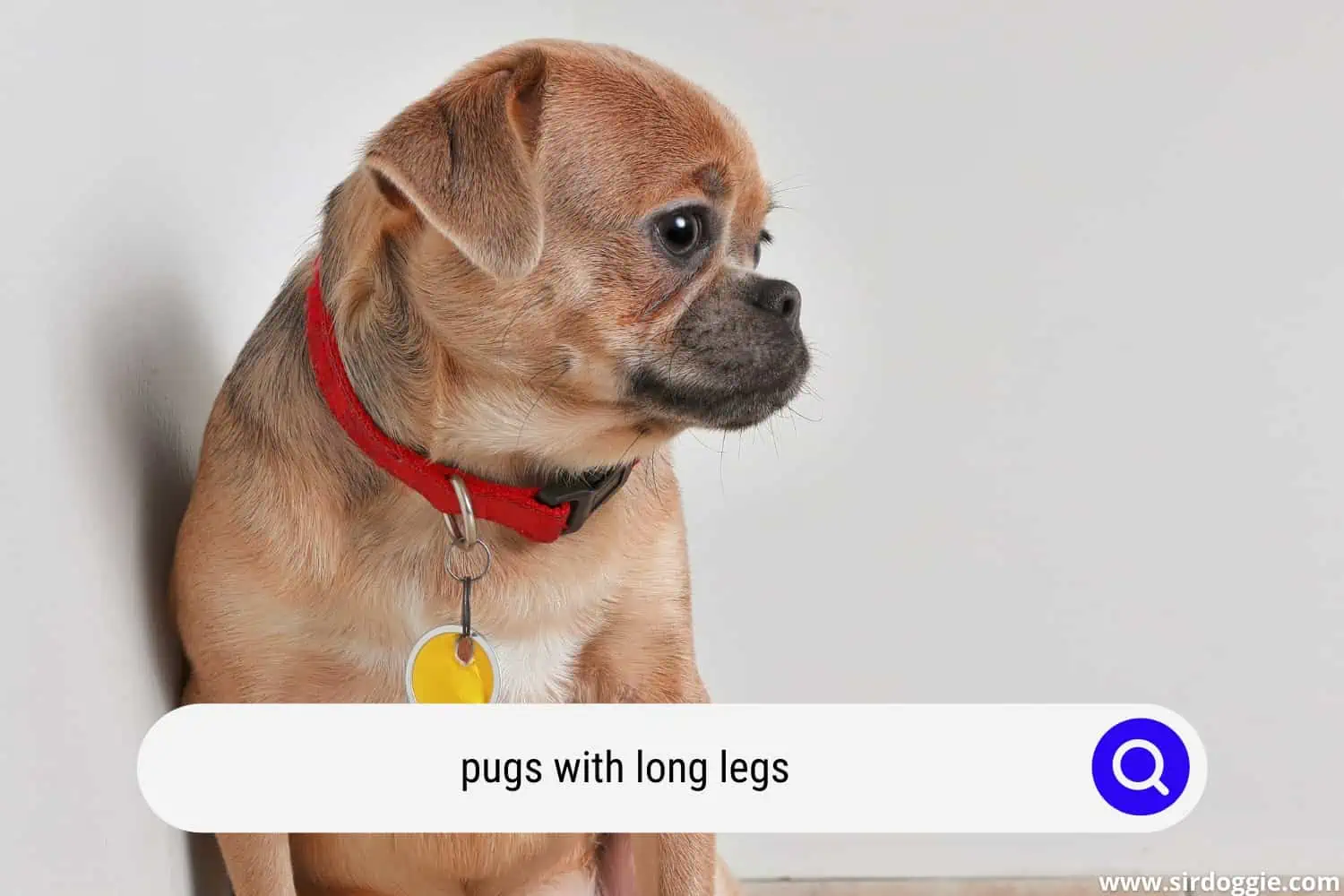Pugs With Long Legs: 7 Smart Cross-Breeding Options For A Much Healthier Pup
Have you ever seen Pugs with long legs? I bet you have, and it is not as uncommon as one might think. Centuries ago, a Pug’s legs were naturally a lot leaner compared to the way they look now. Just look at the 1802 painting by Chalon “A Favorite Pug,” or an 1850 one “Pug” by Howe where you’ll be able to see the difference between “then” and “now” wrinkled pooches. Standards have changed and modern-day Pugs are required to be short, stocky, bug-eyed, flat-faced with adorable floppy triangle ears hanging off both sides of their heads.
If your Pug matches this description, most likely you have a purebred pal. Yet, many pet parents go out of their way to find mixed Pugs with long legs, the ones who also have longer muzzles and are taller. Why? Because cross-bred wrinkled pals have a lot fewer wellness issues down the road as they mature. Who wouldn’t wish for their fur baby to be happy and healthy, right? If you answered affirmative, then you need to read on to find out who smushy buds can be crossed with to get leaner, stronger Pugs with long legs and prolonged life expectancy.

Pugs With Long Legs: Canine Interbreeding Combinations
1. Terrier
A Pug plus Jack Russel Terrier equals what’s called a “Retro Pug.” One very good reason to get a designer Retro hybrid is a lot fewer health ailments down the road. For example, better breathing that a longer face provides, healthier skin, sharper eyes, and much stronger joint support thanks to longer, leaner legs. On top of all those benefits, your Retro Puggo will be a lot more active and outdoorsy, which is great news for all those summer sports fanatics out there.
2. King Charles Spaniel
If you cross a King Charles Spaniel and a Pug you will get a long-legged Pug or, to be precise, a Pugalier pup as a result. When the first interbreeding of the two very different dog species took place, it turned out to be very beneficial for our squishy-faced bud. Pugs got a longer snout, which helped open up the airways more so they could breathe more easily. Not only that, it gave a Pugalier some much-needed height for better skeletal stability and a very vibrant personality.
3. Beagle
A Puggle is a very social, friendly designer dog breed, that gets a lot of the Pug parent’s features, including their big, bug-like eyes. However, its muzzle is much more elongated compared to Pugs. So, why were two very different canines mixed? The reason is to help brachycephalic wrinkle-faced straighten out their breathing issues and re-create a much healthier pal in the end.
If a pet parent is worried about bone fragility Pugs are prone to, Beagle genes can assist in the formation of a taller, stronger frame all Puggles inherit. Yet, it is not a guarantee that our mixed pup is going to have immunity against hip dysplasia both parent breeds develop with age.
4. Husky
A Hug is a result of a Husky female and a Pug male combo. Why is the former always a mom? That’s because a Husky is a much bigger, stronger breed that can give birth to a big litter of pups, compared to Pug females who often have C-sections to deliver. Hugs grow up to be anywhere from 10” to 24” in height. The Husky Pug mixed puppy is going to be much bigger than the regular Pug, but smaller than the Husky parent. Usually, these pups are much more muscular thanks to the Siberian hounds’ strong genes and, therefore have very sturdy legs.
5. Labrador
Pugadors are medium-sized dogs, right in the middle between a toy breed Pug and a large-sized Lab. Their height is about 15-19 inches on average and they weigh no more than 50 lbs. Hence, Pugador puppies are much leaner compared to their Pug daddies (in fair breeding practices the smaller breed should be the father) and have fewer joint issues.
6. German Shepherd
A Shepherd mom and a Puggo dad will produce a Shug puppy: a very active, lively, and extremely loyal companion. They reach up to 17 inches in height and weigh up to 60 pounds. The two parent breeds were crossed to get a much more intelligent, as well as a healthy pal while preserving the spunk and charisma of a Pug father.
Shugs are much smaller than their German relative and, therefore are suitable for tiny households that can’t properly accommodate a huge Shepherd pooch. Yes, the latter will give a designer dog baby its long, straight limbs. However, some German Shepherds are inclined to get certain joint problems like their flat-faced canine counterparts. A reputable breeder will screen out pups in the litter who are potentially at hip dysplasia risk.
7. Boston Terrier
A very easy-to-train, happy, and active Bugg will be a great addition to any household type, big or small. They also suffer from brachycephalic syndrome like their flat-faced relatives, yet they are more muscular and nimble in comparison with Puggo’s parents. A Terrier gives them stronger skeletal make-up, which reduces the chances of any type of bone disorder.

Curl-Up
We have just covered the topic of Pug’s legs and who they can be crossed with to get those lean, graceful limbs. In case you were looking for a crossbred Pug, use this article as a guide in finding a one-of-a-kind, stronger, and healthier mutt. Keep in mind: most mixed pups are going to have a lot more energy and are higher maintenance compared to a purebred Puggo. Hence, if you are looking for a lap pooch, look for a pure-blooded wrinkled companion.
FAQs
Is it normal for a Pug to have long legs?
Wrinkled creatures are known for their expressive eyes, cute button snouts, tightly-curled tails, muscular compact body, and short, stalky legs. These are all the characteristics of a purebred Pug. However, if you see a Pug with long legs, think mixed breed. There could be a Jack Russel Terrier or a Beagle in a Pug’s bloodline a generation or two back. Pugs get mixed with other canine species to prevent many health ailments flat-faced buds are notorious for getting: lung collapse, strokes, diabetes, joint, and bone abnormalities that hinder normal walking patterns.
Why do Pugs have short legs?
Smushy-faced pals have a very peculiar skeletal make-up: a stalky, strong body with a flat head and short nimble legs. Pugs are considered a toy breed, therefore the legs are not going to be too long. Over the course of many centuries, Puggos were bred to become smaller and smaller and turned into great lap dogs. If you look at many paintings of the 17th through the 20th century, you will see that they used to be larger compared to the way they look now.
Yet, many Pug sellers are coming back to the old ways as far as Pug breeding is concerned: they are mixing them with bigger dog species like Beagle, Cocker Spaniel, or Terrier. Their short limbs cause a lot of problems for a little button-nosed friend: hip dysplasia, Legg-Perthes disease, and arthritis. That’s why so many breeders opt for a healthy interbreeding practice to help eliminate some of the issues Pugs are suffering from.

Family Dog Expert Author
Hi there! I’m Stuart, a devoted dog lover and family dog expert with over a decade of experience working with our furry companions. My passion for dogs drives me to share my knowledge and expertise, helping families build strong, loving bonds with their four-legged friends. When I’m not writing for SirDoggie, you’ll find me hiking, playing with my beautiful dog, or studying music.